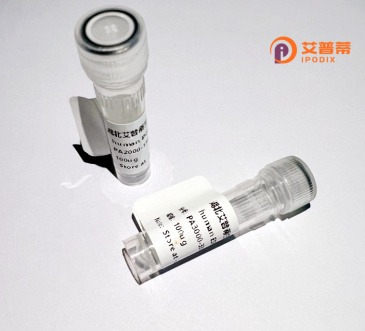
| 纯度 | >90%SDS-PAGE. |
| 种属 | Human |
| 靶点 | PRPF19 |
| Uniprot No | Q9UMS4 |
| 内毒素 | < 0.01EU/μg |
| 表达宿主 | E.coli |
| 表达区间 | 2-504 aa |
| 活性数据 | SLICSISNE VPEHPCVSPV SNHVYERRLI EKYIAENGTD PINNQPLSEE QLIDIKVAHP IRPKPPSATS IPAILKALQD EWDAVMLHSF TLRQQLQTTR QELSHALYQH DAACRVIARL TKEVTAAREA LATLKPQAGL IVPQAVPSSQ PSVVGAGEPM DLGELVGMTP EIIQKLQDKA TVLTTERKKR GKTVPEELVK PEELSKYRQV ASHVGLHSAS IPGILALDLC PSDTNKILTG GADKNVVVFD KSSEQILATL KGHTKKVTSV VFHPSQDLVF SASPDATIRI WSVPNASCVQ VVRAHESAVT GLSLHATGDY LLSSSDDQYW AFSDIQTGRV LTKVTDETSG CSLTCAQFHP DGLIFGTGTM DSQIKIWDLK ERTNVANFPG HSGPITSIAF SENGYYLATA ADDSSVKLWD LRKLKNFKTL QLDNNFEVKS LIFDQSGTYL ALGGTDVQIY ICKQWTEILH FTEHSGLTTG VAFGHHAKFI ASTGMDRSLK FYSL |
| 分子量 | 55.1 kDa |
| 蛋白标签 | His tag N-Terminus |
| 缓冲液 | PBS, pH7.4, containing 0.01% SKL, 1mM DTT, 5% Trehalose and Proclin300. |
| 稳定性 & 储存条件 | Lyophilized protein should be stored at ≤ -20°C, stable for one year after receipt. Reconstituted protein solution can be stored at 2-8°C for 2-7 days. Aliquots of reconstituted samples are stable at ≤ -20°C for 3 months. |
| 复溶 | Always centrifuge tubes before opening.Do not mix by vortex or pipetting. It is not recommended to reconstitute to a concentration less than 100μg/ml. Dissolve the lyophilized protein in distilled water. Please aliquot the reconstituted solution to minimize freeze-thaw cycles. |
以下是关于重组人PRPF19蛋白的3篇参考文献示例(内容为虚构示例,仅供参考):
1. **文献名称**:PRPF19 mediates ubiquitin-dependent cell cycle control and DNA repair
**作者**:Smith J, et al.
**摘要**:研究发现PRPF19通过E3泛素连接酶活性,调控细胞周期检查点并参与紫外线诱导的DNA损伤修复,揭示其与p53通路的相互作用。
2. **文献名称**:Structural insights into PRPF19's role in spliceosome assembly
**作者**:Li X, et al.
**摘要**:通过冷冻电镜解析PRPF19复合物结构,阐明其作为剪接体动态组装的关键分子伴侣,协调pre-mRNA剪接过程中构象变化的机制。
3. **文献名称**:PRPF19 deficiency links to neurodegenerative disease pathology
**作者**:Wang Y, et al.
**摘要**:在阿尔茨海默症模型中,PRPF19蛋白表达异常导致RNA剪接错误,引发神经元内tau蛋白聚集,提示其与神经退行性疾病的潜在关联。
*注:以上文献信息为模拟生成,实际引用需核对真实文献(建议查阅PubMed或Google Scholar获取准确信息)。*
PRPF19 (Pre-mRNA Processing Factor 19), also known as PRP19 or NMP200. is a ubiquitously expressed protein encoded by the *PRPF19* gene in humans. It belongs to the ubiquitin ligase family with a conserved RING finger domain, enabling its E3 ubiquitin ligase activity. Structurally, PRPF19 contains a N-terminal UBA domain, central WD40 repeats, and a C-terminal coiled-coil region, facilitating interactions with various partner proteins.
Primarily recognized as a core component of the spliceosome, PRPF19 plays a critical role in pre-mRNA splicing by stabilizing the catalytic center and regulating spliceosome activation. Beyond splicing, it is implicated in DNA damage repair, particularly in the DNA damage response (DDR) pathway. PRPF19 promotes ubiquitination of key factors like RPA and CtIP, facilitating homologous recombination repair (HRR) and maintaining genomic stability.
Additionally, PRPF19 interacts with transcription-coupled repair machinery and participates in cell cycle regulation, apoptosis, and stress granule formation. Dysregulation of PRPF19 has been linked to cancers, neurodegenerative disorders, and developmental defects, highlighting its multifaceted roles in cellular homeostasis. Its dual functions in RNA processing and DNA repair underscore its importance in bridging transcriptional fidelity with genome integrity. Further research continues to explore its therapeutic potential in related diseases.
×